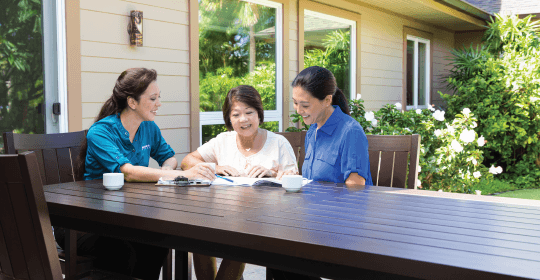When a loved one is discharged from a hospital or other medical facility, the caregiver plays a critical role in lessening the chance of readmission. Among discharged Medicare patients, nearly 20 percent will be readmitted within 30 days. As a caregiver, taking the time to understand and follow the discharge plan will help lower your loved one’s risk of making a quick second trip to a health care facility.
What is discharge planning?
The Department of Health and Human Services defines discharge planning as “a plan for when a patient or resident leaves a care setting.” These care settings can include acute and long-term care hospitals, rehabilitation facilities, hospices, and psychiatric facilities. Healthcare professionals and patients participate in discharge planning activities together, alongside caregivers.
Why is it important?
With effective discharge planning, patients are much less likely to return to the hospital, receive improper care, or further harm themselves. Reduce complications by planning ahead and ensuring everyone involved in the care process has accurate information.
Discharge plan checklist
Most facilities will have a formal discharge sheet. Sometimes they only fill this form out for their own records, so be sure to ask for a copy or a set of notes. Here are a few items that you should make sure are listed on your senior’s discharge plan:
- The next destination for the patient.
- Names and numbers of other caregivers.
- Notes on health condition and tips on improvement.
- Name and number of a health care professional to call if complications occur.
- Names and dosages of prescription drugs, over-the-counter-drugs, and vitamins.
- Special activities the caregiver will need to perform for the patient.
- Any special equipment needed, like a walker or wheelchair.
- Instructions related to diet or exercise.
- Future appointments.
- Written discharge instructions from an assigned health care professional.
Whether your loved one is leaving a hospital, rehabilitation center, or other type of care facility, preparing properly for the discharge will ensure the safest, smoothest transition for your ohana.
This article is for general information purposes only and does not constitute medical advice nor is it intended to diagnose health problems. Readers should first consult with their physician or health care provider before acting upon any information in this article.


When a loved one is discharged from a hospital or other medical facility, the caregiver plays a critical role in lessening the chance of readmission. Among discharged Medicare patients, nearly 20 percent will be readmitted within 30 days. As a caregiver, taking the time to understand and follow the discharge plan will help lower your loved one’s risk of making a quick second trip to a health care facility.
What is discharge planning?
The Department of Health and Human Services defines discharge planning as “a plan for when a patient or resident leaves a care setting.” These care settings can include acute and long-term care hospitals, rehabilitation facilities, hospices, and psychiatric facilities. Healthcare professionals and patients participate in discharge planning activities together, alongside caregivers.
Why is it important?
With effective discharge planning, patients are much less likely to return to the hospital, receive improper care, or further harm themselves. Reduce complications by planning ahead and ensuring everyone involved in the care process has accurate information.
Discharge plan checklist
Most facilities will have a formal discharge sheet. Sometimes they only fill this form out for their own records, so be sure to ask for a copy or a set of notes. Here are a few items that you should make sure are listed on your senior’s discharge plan:
- The next destination for the patient.
- Names and numbers of other caregivers.
- Notes on health condition and tips on improvement.
- Name and number of a health care professional to call if complications occur.
- Names and dosages of prescription drugs, over-the-counter-drugs, and vitamins.
- Special activities the caregiver will need to perform for the patient.
- Any special equipment needed, like a walker or wheelchair.
- Instructions related to diet or exercise.
- Future appointments.
- Written discharge instructions from an assigned health care professional.
Whether your loved one is leaving a hospital, rehabilitation center, or other type of care facility, preparing properly for the discharge will ensure the safest, smoothest transition for your ohana.
This article is for general information purposes only and does not constitute medical advice nor is it intended to diagnose health problems. Readers should first consult with their physician or health care provider before acting upon any information in this article.